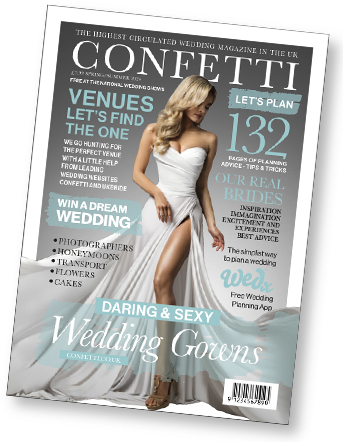You may think that bridal veils are worn simply to lend an air of mystery to a bride, but in fact there are many reasons for why this essential accessory was first clipped into place.
 Above: As You Like It wedding veils
Above: As You Like It wedding veils
Bridal veils in history
The Romans used them to symbolise the flame of Vesta, goddess of the home and provider of life. Some say they were used centuries ago to ward off any evil spirits that may have been surrounding a bride. Others say they are a gesture to the ancient tradition of the carrying‐off of a bride by the groom, during which he would throw a blanket over her to make the task more manageable.

 Above: Jane and Andy’s Elegant Real Wedding at Armathwaite Hall
Above: Jane and Andy’s Elegant Real Wedding at Armathwaite Hall
Styles for bridal veils
Veils are roughly split into categories according to length, from shoulder through to cathedral‐length, the longest and most formal. Delicate creations are often made from tulle, and they are often incorporated into hats or headdresses.
- Shoulder ‐‐ a short piece covering the head and neck.
- Elbow ‐‐ falls halfway down arm length.
- Fingertip ‐‐ just as it sounds, extends down to the hands.
- Chapel ‐‐ floor‐length, for true romantics.
- Cathedral ‐‐ the real thing! A long, flowing, fairytale headpiece designed to trail behind you as you walk. Will require bridesmaids!
 Above: Lisa and Ben’s Colourful Beach Real Wedding
Above: Lisa and Ben’s Colourful Beach Real Wedding
Veils for the modern bride
Today, veils usually serve as the finishing touch to a gown. But they can also help a bride meet her ‘something old/new/borrowed/blue’ quota, depending on taste and family heirlooms…

Whatever your taste, you’ll find no shortage of choice, but don’t panic ‐‐ picking a style is easy, as long as you stick to the practical side of things. Follow our failsafe guide and you can’t go wrong:
- Pair up: the most obvious tip is to buy your dress and the veil together, or get the veil custom‐made to match your dress. This way you can be sure that one won’t clash with the other.
- Long story: the taller you are, the longer your veil should be, to match your height.
- Easy does it: if your dress is detailed, keep the veil simple.
- Waist not: a long veil can help take the emphasis off a wide waist, but make sure it doesn’t take attention away from any bows or details down the back of your dress.
- Face off: if your veil covers your face, keep it at bust height so that it doesn’t cover your flowers.
- Head and shoulders: it’s not just the shape of your dress that you need to consider when choosing a veil ‐‐ a bride’s head, face and neckline should also be considered too.
- Practice makes perfect: if your veil is floor‐length, carefully practise walking about in it before launching yourself down the aisle. Or make sure your bridesmaids are in charge of keeping it out of the way.
- Stay secure: your hairdresser should be informed well in advance of the kind of veil you plan to wear, so it can be made as secure as possible.
- Overcoat: for winter weddings, wear a hooded cloak matching a lighter dress underneath. Have the cloak for the ceremony, to keep you warm in wintry churches, and remove it later on at the reception, where food, wine and dancing should heat you up nicely!
- Hire away: a wedding dress can be customised and worn again, but this isn’t so easy with veils. Whatever you’ve arranged for your dress and wedding shoes, hiring a veil will save you valuable pennies.
- Holy Communion: consider buying a communion veil, a fraction of the cost of a wedding veil but essentially serving the same purpose.
- DIY: as in “decorate it yourself”. If you trust yourself as being handy with the glue and sequins then buy a simple veil and go crazy with adornments.
 Above: Lucy and Adam’s Real Wedding
Above: Lucy and Adam’s Real Wedding
If you’re struggling to find a wedding veil,take a browse in our Jewellery Tiaras and Accessories section in the wedding directory!
And if you need some extra help, there are hundreds of brides brimming with helpful tips and advice in the Confetti Forums!


